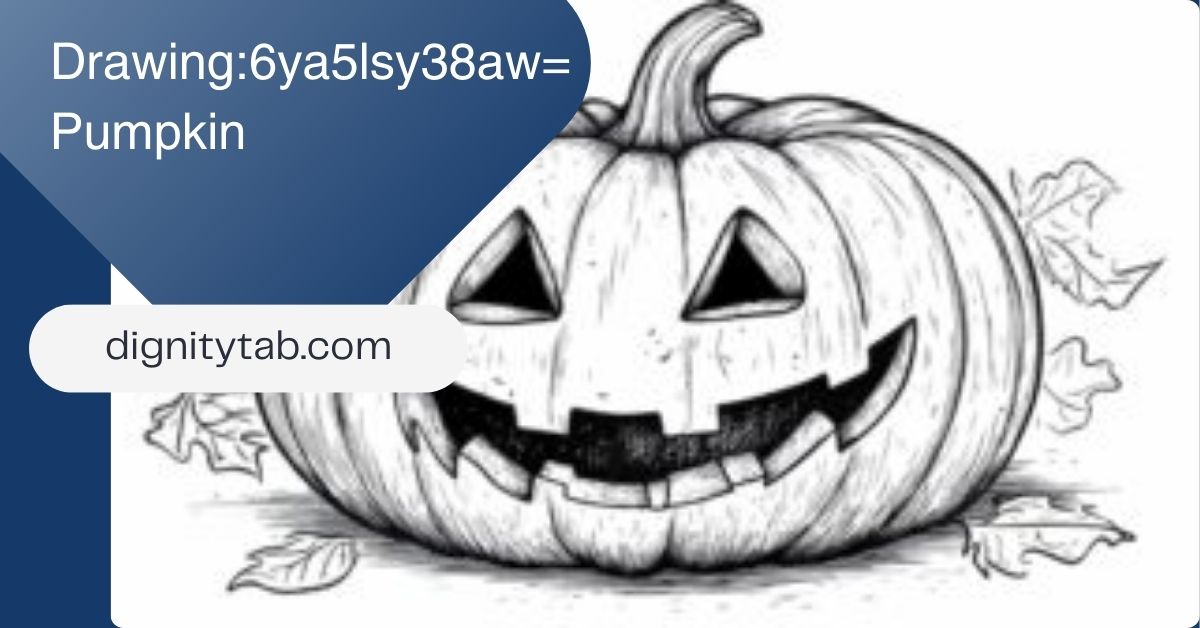Pumpkins are a classic symbol of fall, often associated with Halloween, Thanksgiving, and harvest festivals. The art of “drawing:6ya5lsy38aw= pumpkin” has captivated artists and creatives for centuries, offering a chance to explore vibrant colors, intricate textures, and seasonal imagery. This article will delve into the techniques, inspirations, and creative tips for drawing pumpkins, making it easy for beginners and experienced artists alike to master this timeless subject.
What is Drawing:6ya5lsy38aw= Pumpkin?
The term Drawing:6ya5lsy38aw= Pumpkin refers to the artistic practice of drawing pumpkins in various styles and forms. While the title may seem unusual, it represents the idea of exploring pumpkins through art. These drawings can vary from realistic renderings to more abstract or stylized interpretations, all showcasing the unique shapes, textures, and colors that pumpkins have to offer.
Whether you’re drawing for personal enjoyment or creating art for a project, this subject provides a wealth of inspiration. The act of drawing pumpkins can also serve as a fun way to celebrate the fall season, allowing artists to connect with the spirit of harvest and the changing colors of nature.
Why Draw Pumpkins?
Drawing pumpkins is a popular activity for artists of all ages and skill levels. Here are a few reasons why this subject is so beloved:
- Seasonal Charm: Pumpkins are closely tied to fall traditions and holidays like Halloween and Thanksgiving. Drawing them brings the warmth and spirit of these seasons into your artwork.
- Textural Exploration: The pumpkin’s unique shape and texture provide an exciting challenge for artists to explore shading, highlighting, and detailing.
- Creativity: Artists can experiment with different styles, from lifelike portraits to fun, whimsical designs that reflect their own personal creativity.
- Universal Appeal: Whether for greeting cards, home decor, or personal art collections, pumpkin drawings have broad appeal and are instantly recognizable.
Materials and Tools for Drawing Pumpkins
Before diving into your pumpkin drawing, it’s essential to choose the right materials. Whether you’re sketching on paper, using digital tools, or working on a canvas, the following materials will help you create the best pumpkin artwork possible.
Traditional Drawing Tools
- Pencils: Start with a set of pencils ranging from light to dark (e.g., H, B, 2B, 6B) to achieve various shading effects and details.
- Paper: Choose a good-quality drawing paper, preferably with a bit of texture (like cold-pressed watercolor paper), to allow for better shading and depth.
- Erasers: A kneaded eraser is ideal for creating subtle highlights, while a regular eraser can help with mistakes or correcting outlines.
- Colored Pencils: To bring your pumpkin to life, colored pencils are perfect for adding layers of color and detail.
- Charcoal: For a more dramatic and expressive pumpkin drawing, charcoal can help you achieve rich blacks and deep shading.
Digital Tools
If you prefer digital art, consider using a drawing tablet or a graphics program like Adobe Photoshop or Procreate. Digital art allows you to easily manipulate colors, experiment with different effects, and refine your pumpkin drawings with ease.
Step-by-Step Guide to Drawing a Pumpkin
Step 1: Sketch the Basic Shape
Start by lightly sketching the basic shape of the pumpkin. Pumpkins are generally round or slightly oval, but the size and proportions can vary. Draw a simple circle or oval shape to form the base of your pumpkin.
Step 2: Add the Stem
Next, sketch the pumpkin’s stem. The stem can be short or long, and its shape can vary depending on the type of pumpkin you’re drawing. It typically protrudes from the top of the pumpkin and has a slight curve to it.
Step 3: Create the Ridges
Pumpkins have distinctive ridges that run vertically from top to bottom. Using light lines, sketch the curve of these ridges across the pumpkin’s body. The ridges should follow the natural curvature of the pumpkin and become slightly more spaced out as they move toward the bottom.
Step 4: Add Details and Texture
Now, begin adding details to make the pumpkin look more lifelike. Use short, curved lines to suggest the texture of the pumpkin’s skin. Add fine lines or small dots where the skin folds or around the ridges to create depth.
Step 5: Shading and Highlights
Shading is crucial for adding realism to your pumpkin drawing. Lightly shade the areas of the pumpkin that are furthest from the light source. For a more natural effect, use a combination of darker tones around the base and lighter tones on the top where the light hits.
Add highlights along the ridges and areas that would catch light. You can use a kneaded eraser to gently lift off some of the shading and create subtle highlights.
Step 6: Color (If Desired)
If you’re using colored pencils, markers, or digital tools, now is the time to add vibrant colors to your pumpkin. Traditional pumpkins are usually shades of orange, but feel free to experiment with different colors or even create a unique multicolored pumpkin!
Step 7: Final Touches
After completing the shading and coloring, go over your drawing one last time. Add any additional details or adjustments to improve the overall balance and realism of the piece.
Different Styles of Drawing:6ya5lsy38aw= Pumpkin
1. Realistic Pumpkin Drawing
A realistic pumpkin drawing involves capturing every small detail of the pumpkin’s shape, texture, and color. The focus is on precision, using shading and highlights to replicate the pumpkin as accurately as possible.
2. Cartoon-Style Pumpkin
A cartoon-style pumpkin drawing is more playful and exaggerated. You can focus on bold outlines, bright colors, and larger-than-life expressions to create a whimsical pumpkin character.
3. Abstract Pumpkin Drawing
In an abstract pumpkin drawing, the focus shifts away from realism. You can experiment with geometric shapes, unique color combinations, or patterns to express the essence of a pumpkin in a non-literal way.
4. Pumpkin with Faces (Jack-O’-Lanterns)
Another fun style of pumpkin drawing is the Jack-O’-Lantern, especially popular during Halloween. These pumpkins feature carved faces, and artists often draw them with eerie expressions, using strong contrasts and shadows.
5. Watercolor Pumpkin Art
For a more delicate and soft effect, watercolor techniques can be used to paint a pumpkin. This method captures the natural flow of colors and light, adding a whimsical feel to the artwork.
Creative Tips for Drawing Pumpkins
1. Experiment with Different Pumpkin Types
Not all pumpkins are orange! Consider drawing different varieties, such as the white pumpkin, the bumpy-textured Cinderella pumpkin, or even a green pumpkin. Each type offers unique shapes and textures to explore.
2. Play with Light and Shadow
Lighting plays a huge role in how your pumpkin drawing will look. Experiment with different lighting sources, such as light from above, from the side, or a more dramatic light that creates deep shadows and contrasts.
3. Incorporate Seasonal Elements
To make your pumpkin drawing even more festive, consider incorporating elements of the fall season. Draw leaves, vines, or even a spooky background to create a more complete autumn scene.
4. Add Creative Flair
If you’re drawing a pumpkin for a specific holiday like Halloween or Thanksgiving, consider adding your personal flair. For example, you could draw pumpkins surrounded by fallen leaves, or create a pumpkin with intricate carvings or designs.
FAQs about Drawing:6ya5lsy38aw= Pumpkin
What materials do I need to start drawing pumpkins?
To start drawing pumpkins, you’ll need pencils, erasers, colored pencils or markers, and high-quality paper. If you prefer digital art, you can use a tablet or drawing software like Procreate.
What are some easy pumpkin drawing ideas for beginners?
For beginners, try drawing a simple pumpkin shape with basic shading. Focus on sketching the ridges and stem, then gradually add details like texture and highlights.
How can I make my pumpkin drawings look more realistic?
To make your pumpkin drawings more realistic, focus on shading and highlighting. Use varying degrees of pencil pressure to create soft gradients, and consider using reference photos of real pumpkins to help guide your work.
Can I draw a pumpkin in a digital art program?
Yes, digital drawing tools like Photoshop and Procreate are great for creating pumpkin art. You can use layers to experiment with colors, shading, and textures, making the drawing process easier to refine.
How do I add personality to my pumpkin drawing?
To add personality, consider giving your pumpkin a face, unique texture, or an unexpected color. You can also play around with the shape, size, and arrangement of the pumpkin in your drawing to make it stand out.
Conclusion
Drawing pumpkins, or “drawing:6ya5lsy38aw= pumpkin,” is a fun and creative activity that brings out the beauty of fall. Whether you prefer realistic depictions or more whimsical interpretations, pumpkins provide a rich source of inspiration. By experimenting with different styles, materials, and techniques, you can bring your pumpkin drawings to life and capture the spirit of the season in your artwork. So grab your pencils, markers, or digital tools, and start creating your own pumpkin masterpiece today!



